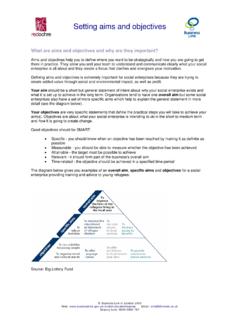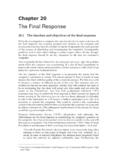Transcription of Essential Guide to Strategic Planning - Compass Partnership
1 ASSOCIATION OF CHIEF EXECUTIVES OF VOLUNTARY ORGANISATIONSE ssential Guide toStrategic PlanningWritten and Supported by: Compass PartnershipacevoEssential Guide to Strategic Planning2 ContentsIntroduction .. 3 Part 1: Essential concepts .. 3 Part 2: Application .. 6 Brook - a case study .. 7 Further 7 Compass Partnership .. 8 Copyright Compass PartnershipPlease note this electronic document is intended for the use of the purchaser and should not be emailed or copiedto third parties without the prior permission of Guide to Strategic Planning3 IntroductionThis Essential Guide aims to give you an overview ofstrategic Planning in voluntary organisations. It is designedas a series of check lists of issues that Chief Executives,managers and trustees need to think about whenembarking on the development of a new Strategic 1 covers the Essential concepts that underpin effectivestrategic 2 highlights the critical topics that need to beconsidered when designing and implementing a strategicplanning Guide is aimed particularly at organisations with morethan one some of the theory andpractice is applicable to smaller organisations, a lesssophisticated approach to Planning is more appropriate inthese organisations have to climb a learning curve in strategicplanning.
2 Getting the concepts embedded into everyone sheads takes considerable effort when an organisation isembarking on Planning for the first time or when it has notrenewed its Strategic plan in the last five years. Fortunately,once the concepts are understood and the organisationhas established processes for Planning ,considerably lesseffort is required to maintain the Planning , if the task of establishing or renewing a strategicplanning process seems a bit daunting, remember, manyorganisations have climbed the learning curve anddiscovered that Strategic Planning is one of the mostpowerful management tools in the Chief Executives andTrustees tool 1: Essential ConceptsWhat is strategy?
3 Strategies are broad categories of action through whichhuman and financial resources will be deployed toachieve agreed objectives. Strategies need to be rooted in the organisation smission and to take account of its policies and values. Strategies need to be dynamic, responding to changes inexternal circumstances and not fixed in concrete. Strategies exist at different levels: overall strategy for whole organisation; divisional strategy for groups of services (in largerorganisations); service, campaign and fund-raising strategies forindividual parts of the organisation. This Guide is about overall is a Strategic plan? A Strategic plan is a statement of how the organisation isgoing to achieve its mission and objectives.
4 Strategic plans usually contain the following elements: the organisation s mission; objectives which the organisation aims to achieve; strategies for achieving the objectives; specific targets to be attained within agreed timescales; a procedure for reviewing progress and modifyingplans. The benefits of Strategic Planning are that it: clarifies the organisation s purpose; sets direction and objectives; helps to identify and address key issues; develops commitment to the organisation s objectives; motivates staff and volunteers; helps with the allocation of Guide to Strategic Planning4 Who is responsible for strategy? Ensuring an organisation has a demanding and credible strategy is a governing body responsibility.
5 Management is usually responsible for developing strategies in close consultation with the governing body. More than anyone else, the Chief Executive is responsible for developing and managing the process of Planning . The governing body is responsible for reviewing performance against plans and holding management accountable forachieving the agreed are Strategic plans developed? Strategic plans are often developed in two stages:i) A review of past objectives, strategy and the changing external environment. The review should summarise theorganisation s Strategic position - a statement of where the organisation is now and how the world around it ) The development of new strategies and plans.
6 This should set out what the organisation intends to achieve overalland its broad strategies for achieving its of a Strategic Planning processWhat information should be gathered for strategy reviews? The external part of the review should summarise key changes in the world around the organisation: social and economic trends; political and legislative changes; technological developments; trends in size and needs of user groups (for service delivery organisations); trends in funding sources and methods; Strategic developments in other organisations existing for similar purposes. All external review data needs to focus sharply on trends as they affect your positionKeyissues to addressChoicesThe PlanBudgetImplementationReview StagePerformance MonitoringImplementation StageP lanning StageExternal ReviewInternal ReviewReviewProposals Mission Objectives StrategiesOverview of a Strategic Planning ProcessacevoEssential Guide to Strategic Planning5 Internal reviews gather data on: achievements of current services or campaigns; facts about current services (for service deliveryorganisations) including trends in: number of people assisted; characteristics of people given assistance; types of assistance given.
7 Costs incurred or subsidy given to each service orcampaign; trends in the use of human, physical andfinancial resources; intangible resources ( reputation, contacts). The data from external and internal reviews should bedrawn together to identify the key issues that theorganisation needs to address to increase its overalleffectiveness. The data should also be used to identifythe key opportunities and threats the organisation are the key Strategic issues identified? Strategic issues can be identified by trustees, managersor other stakeholders. It is often valuable to ask people to identify the threemost pressing Strategic issues the organisation needs toaddress.
8 A joint trustee management away-day can be used to get agreement of the most pressing issues. Avoid the danger of writing the issues in ever moregeneral terms in order to get mustremain sharp and specific to be useful for should Strategic plans be used? Strategic plans document the assumptions that havebeen made and the conclusions and agreements thathave been reached. The plan should be used as: a means of building consensus and commitment tofuture objectives and priorities; a means of communicating the strategy throughoutthe organisation; a framework for operational Planning and budgetsetting; the basis for reviewing terminologyObjectivesSpecific, Measurable,Actionable,Realistic, time-framed statementsabout what your team aims of activities thatdemonstrate how an objective willbe key things the organisation willdo to achieve its principal steps required tocomplete each activity, eachresulting in an identifiable money, people, time, facilitiesand equipment relationshipdependenciesbetween the activities planned bydifferent parts of the direct product of an activity,often measured in volume benefits that activities bring(for example to service users).
9 Performance Clearly-defined output or outcome measuresindicators used to measures trackthe success of your the organisation will haveachieved by specified Guide to Strategic Planning6 Part 2: ApplicationWhat are the pre-conditions for effectiveplanning? Strong commitment from the Chair and Chief Executive. Reasonable stability in the Senior Management Team. Willingness to have open and honest discussions aboutthe key issues the organisation faces. Lack of crises threatening immediate future of should be involved at different points ofthe process?What should you think about when Planning theplanning process? Legitimising the process with Trustees,management,staffand volunteers.
10 Involving all the organisation's stakeholders such as users,funders,Trustees, staff and volunteers, and gaining theircommitment to future plans and priorities. Integrating Planning with budget setting. Finding people to challenge conventional wisdom. Communicating the strategy throughout theorganisation. Processes for recording progress and are typical timescales? Timescales depend on previous Planning experience andthe complexity of consultation. Allow a 1-2 month period to plan the Planning process,consult and gain agreement to the approach. Allow 2-4 months to prepare the review and consult. Allow 2-4 months to prepare the plan and consult. Planning takes more time in larger organisations andones offering many are the common pitfalls?







